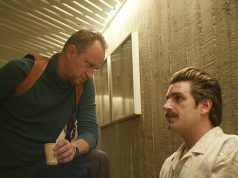I am confident that having seen “Mardi Gras: Made in China,” I will never expose my breasts in exchange for beads again. Between this and “Super Size Me,” no one’s ever going to want to do anything fun anymore.
This is a wry, eye-opening documentary about the Chinese sweatshops that manufacture the strings of beads tossed out as prizes for flashing one’s flesh during Mardi Gras in New Orleans. Everyone’s familiar with the tradition (which the film says began in 1978, by the way); but where do those beads come from? Have you ever thought about that?
David Redmon has. A writer who has never made a film until now, he followed the beads’ genealogy back to the industrial town of Fuzhou, China, where there is a factory that is the world’s largest producer of beads and other Mardi Gras-related trinkets. Some 500 employees live on the premises and make beads for at least 14, and as many as 20, hours a day. For this they are paid approximately $1.20 a day — low even by the standards of sweatshop-dense Fuzhou.
Redmon interviews the factory owner, Roger Wong, extensively, and he is indeed a piece of work. He makes about $2 million a year and is a calm, wildly delusional man. He says the factory workers’ pay is fair, and he thinks they have enough free time to develop friendships among one another, even though they are not allowed to speak during working hours. Roger Wong believes his factory is like a big ol’ summer camp.
He says he has never had a strike in his factory. “When you treat your workers like friends, why would they stop working?” he asks. Good question: Maybe you should ask the workers who DID go on strike, you lying sack.
The way he treats his “friends,” apart from paying them $1.20 a day, is fining them one month’s salary if a member of the opposite sex is caught in their living quarters. (Granted, it’s not usually a problem, since 95 percent of Wong’s employees are women, because it is “easier to control the lady workers.”) There are similar fines for talking during working hours or for not meeting production quotas. Indeed, when you are treated that way, why would you ever leave?!
Redmon shows a healthy outrage at all this, but he is not so inflamed that his film becomes an angry screed. His attitude is one of amazement and indignation, not of a ranting activist.
He interviews several girls who work in the factory, and their attitudes are diverse. One actually doesn’t seem to mind the job; her home life was boring anyway. Another feels trapped; another is constantly homesick. One is working there so that her younger brother can have a better life, having pinned all her hopes on him. All of this is intercut with Roger Wong, lying about factory conditions and claiming to believe that everyone is happy under him.
Redmon’s sharpest move is taking footage of his visit to China to Bourbon Street to show the revelers where their ill-gotten beads came from. The contrast here is unmistakable: From teenage girls who work 20 hours a day, we go to privileged American youth who have so much spare time they can afford to spend a week in New Orleans being drunk and naked.
The debauchers’ reaction to the China footage is predictable: Some don’t care, while others admit their buzz has been seriously killed by these sober revelations.
The Chinese girls’ response to seeing Mardi Gras footage is amusing, too. They had never seen what actually happens to the beads they make, and they had no idea women were flashing their breasts in order to get them. “They remove their clothes?” one of them says. “They like (the beads) that much?”
Redmon’s only significant misstep is in showing a man who makes art out of the beads, which registers a big fat “Who cares?” in comparison to the film’s other, more important issues. The movie isn’t about beads, after all. It’s about the cultural gap between West and East, and about the exploitation that capitalism sometimes causes. If Redmon ever devises another topic as fascinating as this one, I have no doubt that his second film will be even better than his first.
(Note: This review is of the version of the film that played at the Sundance Film Festival in 2005. I believe it has undergone some tinkering since then, though how significant the changes are, I don’t know.)
B+ (1 hr., 15 min.; )





